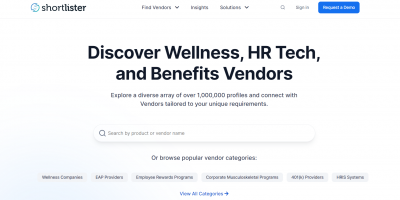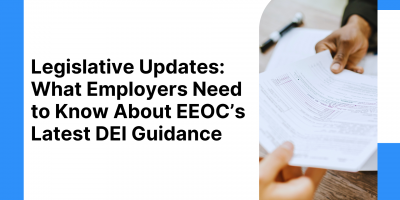
Shortlister Recognized as Best HR Software by Leading Software Directory Research.com
Their recognition of Shortlister emphasizes the platform’s dedication to providing an efficient, data-driven approach to selecting HR and benefits vendors.

President Donald J. Trump’s second term began with a record number of executive orders, presidential memoranda, and directives signed after he was sworn in.
With a bold push for policy changes, Trump’s actions during his first week in office signaled that workplace regulations and employer responsibilities were set for major overhauls.
As of the writing of this article, the following key legislative and regulatory changes have already begun to affect businesses across industries.
On his first day in office, President Trump signed a number of executive orders, some of which address the use of DEI programs in the federal workforce, federal contracts, and the private sector.
The two most impactful Executive Orders to directly impact DEI are:
Executive Order 14151, “Ending Radical and Wasteful Government DEI Programs and Preferencing,” requires all DEI-related activities within the federal government to cease within 60 days. This includes programs, grants, contracts, initiatives, equity action plans, and DEI performance requirements.
The federal workforce is already feeling the impact, with employees in DEI and DEIA offices being placed on paid administrative leave effective immediately.
The executive order “Ending Illegal Discrimination and Restoring Merit-Based Opportunity” may lead to significant shifts for private-sector employees, whether they work with government contracts or not.
For federal contractors, it repeals Executive Order 11246 (also known as the “Equal Employment Opportunity” order established in 1965) and directs the Office of Federal Contract Compliance Programs (OFCCP) to stop immediately:
In addition, the same executive order also targets the private sector, aiming to end what the administration considers illegal discrimination and DEI-related preferences.
It directs the U.S. attorney general and relevant agencies to develop enforcement plans within 120 days, focusing on industries with major violations.
Large corporations, nonprofits, foundations, professional associations, and wealthy educational institutions could face civil compliance investigations.
The Trump administration has not clearly defined what constitutes “illegal DEI,” leaving companies and institutions uncertain about which practices might be deemed unlawful under the new directives.
As Trump continues to target DEI, a trend is emerging among major companies, with some scaling back initiatives while others dismantle DEI departments.
Google, KPMG, Pepsi, Disney, and Amazon are among the high-profile companies that have reduced or eliminated DEI programs.
Although a federal judge has temporarily blocked these executive orders, uncertainty about the future of DEI still remains.
As political and legal battles unfold, businesses must stay informed and adaptable.
After May 2025, we expect to have clearer guidance from the administration on how its efforts to eliminate DEI programs will affect private-sector employers.
By law, the National Labor Relations Board (NLRB) is designed to have five members, all appointed by the President and confirmed by the Senate.
However, the Board is currently at a standstill due to a lack of quorum.
President Trump fired key officials, including General Counsel Jennifer Abruzzo and Board Member Gwynne Wilcox, leaving the Board with only two members.
With the Board lacking a quorum – the minimum number of members required to conduct business officially, decisions on hundreds of major labor disputes have now come to a stop.
Without at least three of its five seats filled, the NLRB cannot issue rulings on cases, creating a backlog of unresolved labor disputes that could impact unions, employers, and workers nationwide. It could take around four months for the Senate to confirm new NLRB members.
Update Note from 03/07/2025: A federal judge just reinstated Board Member Gwynne Wilcox to the NLRB, ruling that Trump had no authority to fire her.
With her return, the Board finally has the three-member quorum it needs to start issuing decisions again. However, the Trump administration has already filed an appeal, looking to block Wilcox’s return.
For now, employers and unions should expect the NLRB to move forward with decisions, but the ongoing legal battle could bring everything to a halt once again.
While the recent appointment of William B. Cowen as Acting General Counsel may bring some stability, the current situation creates uncertainty for both employers and workers.
That said, it should be noted that a missing quorum does not mean that the NLRB stops all operations, but it does prevent them from issuing decisions on labor disputes and policy changes until enough members are in place.
In other words, the existing labor acts remain fully enforceable, and employers must still comply with all regulations.
However, businesses should be aware that any labor disputes could face delays until the NLRB regains full functionality.
As the Trump administration takes shape, the role of the Occupational Safety and Health Administration (OSHA) in workplace safety is facing both leadership changes and legislative challenges.
OSHA’s future is consistently questioned as some lawmakers continue to push for its elimination.
In early 2025, Arizona Representative Andy Biggs introduced the “Nullify OSHA” Act, a proposal to abolish OSHA and also repeal the Occupational Safety and Health (OSH) Act of 1970, which established federal workplace safety standards.
Despite its ambitious objective, the bill has gained little political traction and currently has no co-sponsors, making its chances of passing highly unlikely.
While many employers wondered whether the Trump administration would enforce workplace safety laws, they now have a clear answer: yes.
President Trump has nominated environmental safety and health consultant David Keeling to head OSHA.
OSHA’s authority could still be weakened through broader deregulation efforts.
President Trump’s executive order requires agencies to eliminate at least 10 existing regulations for every new rule introduced, making it harder for OSHA to issue new safety mandates.
Additionally, the administration has paused some regulations issued late in Biden’s presidency for review. Namely, the regulatory freeze has stopped the progression of safety standards for heat illness and emergency response protocols.
Trump’s broader push for a smaller federal workforce is also underway, with buyouts and terminations reducing agency staff.
So, while OSHA is unlikely to disappear, fewer regulations and a reduced headcount could impact its ability to conduct inspections and enforce workplace safety rules at the same level.
Senior Content Writer at Shortlister
Browse our curated list of vendors to find the best solution for your needs.
Subscribe to our newsletter for the latest trends, expert tips, and workplace insights!

Their recognition of Shortlister emphasizes the platform’s dedication to providing an efficient, data-driven approach to selecting HR and benefits vendors.

What’s the most effective way to go from leads to prospects to paying customers?

February continues the trend of major industry shifts driven by high-impact acquisitions, strategic collaborations, and exciting new products.

What once passed as progress may now risk penalties. Here’s what employers need to know about the EEOC’s latest DEI rules and enforcement shifts.
Used by most of the top employee benefits consultants in the US, Shortlister is where you can find, research and select HR and benefits vendors for your clients.
Shortlister helps you reach your ideal prospects. Claim your free account to control your message and receive employer, consultant and health plan leads.